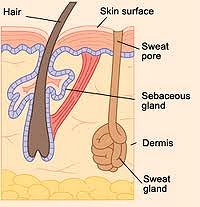

 Wikipedia Sitemap |
|
|  Useful Links 1 Useful Links 2 |

Sweating is a physiological mechanism used to control body heat. The number of sweat glands varies from person to person and has a genetic basis. They are most numerous in the armpits, groin and feet. Many patients I see often have sweat problems confined to their armpits or hands.
Some types of sweat are normal. Gustatory sweating is a good example. I love hot and sour soup, but to consume it I have to put up with the resulting excessive facial sweating, and jokes about how I eat on the run. The spices interact with my autonomic nervous system to produce the gustatory sweating.
Excessive sweating of any kind is called hyperhidrosis. Hormones can interact with sweat glands to make them active especially in adolescents.
Sweat glands have also been implicated in being able to secrete other substances such as sex pheromones. Yet other substances in sweat can react with the bacteria normally found in the armpit. This reaction in turn can produce an unpleasant odor. Interestingly, due to genetic variation in smell capability, different people may perceive body odor in different ways.
The key to control sweat and unpleasant odors starts with regular bathing with an unscented soap. Trimming of hair in these areas also helps. Wearing cotton under-garments helps to absorb the sweat. Cotton is particularly good at helping sweat evaporate. The cooler you remain, the less sweat you generate.
Application of an absorbing agent such as baby powder is another strategy. Be sure that you differentiate between a deodorant and the more expensive antiperspirant. Deodorants will simply mask any odor and have no effect on decreasing sweat.
Antiperspirants such as Aluminium Chlorohydrate are chemicals which irritate the sweat glands' openings making them narrower and less able to produce sweat. Zirconium is the other chemical used in these products.
Deodorant aisles are filled with products touting claims that confuse me. Non-specific labels like "Maximum Protection" have little meaning. Protection from what, one may ask? Odor? Sweat? Drivers who don't signal? You just can't tell.
Simpler measures such as blow drying sweat prone areas after bathing will help reduce bacterial counts. Most people suffering hyperhidrosis are not concerned until body odor becomes the more dominant problem.
A sudden change in sweat production can signal other problems. These can range from damage to the autonomic nerves controlling the sweat pores to various hormonal disorders and obesity. A full investigation is warranted in these cases.
More recently, Botulism Toxin (Botox) injections have been introduced as a means of controlling hyperhidrosis for months at a time. This fix works, but is both expensive and temporary.
A more radical approach is used in the U.S. involving surgery. The procedure is called Endoscopic Thoracic Sympathectomy (ETS). It involves severing the nerves controlling the hyperactive sweat glands. In hot humid climates, hyperhidrosis becomes a more bothersome problem.
Related resources:

● Hyperhidrosis from Wikipedia.
● Hyperhidrosis (Excessive Sweating). Factsheet from Body and Health: Facts on Hyperhidrosis, Causes of Hyperhidrosis, Symptoms and Complications of Hyperhidrosis, Diagnosing Hyperhidrosis, Treating and Preventing Hyperhidrosis.
● Sweaty Glands Blog: Medical problems of sweaty feet, Medical treatment of sweaty glands and sweaty palms, Medical causes of sweaty palms and feet, Sweaty palm treatment: tap water iontophoresis, Sweaty armpit advice, A sweaty palm embarrassment.
● Perspiration from Wikipedia.
● How does sweat work? from Rexona SweatClinic. "When we are hot, the sweat glands are stimulated and release a watery substance which forms the basis of sweat. The sweat is released onto the skin and then evaporates, cooling down the body. "
● How to Prevent Sweaty Palms from eHow.com.
● What's Sweat? from KidsHealth.
● Sweat from MedlinePlus.
● Sweating and Body Odor from Mayo Clinic.
● Hyperhidrosis, Understanding and Treatment Options. Toronto Doctors: Botox Treatment for Excessive Sweating, from No Sweat Clinic.
● Cure Sweaty Hands, Palms, Hyperhidrosis, Hyperhydrosis. YouTube video, 8:33 min.